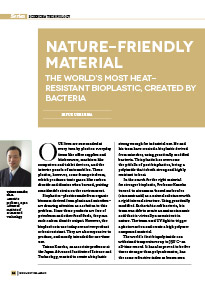Home > Highlighting JAPAN >Highlighting Japan January 2015>Science & Technology
Highlighting JAPAN

Science & Technology
Nature-friendly material
The world’s most heat-resistant bioplastic, created by bacteria

OuR lives are surrounded at every turn by plastics: everyday items like office supplies and kitchenware, machines like computers and tablet devices, and the interior panels of automobiles. These plastics, however, come from petroleum, which produces toxic gases like carbon dioxide and dioxins when burned, putting considerable strain on the environment.
Bioplastics—plastics made from organic biomass derived from plants and microbes—are drawing attention as a solution to this problem. Since these products are free of petroleum and other fossil fuels, they can curb carbon dioxide output. However, the bioplastics in use today are not very robust or heat resistant. They are also expensive to produce, and mostly intended for one-time use.
Tatsuo Kaneko, an associate professor at the Japan Advanced Institute of Science and Technology, wanted to create a bioplastic strong enough for industrial use. He and his team have created a bioplastic derived from microbes, using genetically modified bacteria. This plastic has overcome the pitfalls of past bioplastics, being a polyimide that is both strong and highly resistant to heat.
In the search for the right material for stronger bioplastic, Professor Kaneko turned to cinnamon-based molecules (cinnamic acid) as a natural substance with a rigid internal structure. Using genetically modified Escherichia coli bacteria, his team was able to create an aminocinnamic acid that is virtually nonexistent in nature. The team used UV light to trigger a photoreaction and create a high polymer compound material.
The world’s first biopolyimide can withstand temperatures up to 390˚C—an all-time record. It has also proved to be five times stronger than polycarbonates, has the same refractive index as lenses seen in eyeglasses, and has a low expansion rate like glass. Moreover, biopolyimides naturally snuff out fire when a flame is applied, so they have extreme heat-retardant properties. It was discovered that transparent plastic can be created if produced in a certain way. Even more impressive, the material weighs only half as much as glass, and can be broken down using deep ultraviolet rays and recycled.
Of this material’s future practical uses, Professor Kaneko says, “Lightweight, strong and transparent biopolyimides would be perfect for car windshields.” According to his calculations, using biopolyimides for windshields in hybrid and electric cars would lighten the vehicles by about fifteen kilograms and improve fuel efficiency by 10 percent. As a result of the reduced gasoline consumption, switching the windshields of automobiles all over the world to biopolyimide would also reduce carbon dioxide emissions by over thirteen megatons a year. Given its fire-retardant qualities, using the material in components around the engine would also allow even lighter construction.
Producing aminocinnamic acid, the raw material for the biopolyimide, chemically from petroleum would be very expensive, but doing so through biological processes would cost as little as manufacturing food additives. This economic entry point is one of the merits Professor Kaneko focused on when searching for the perfect material in his quest to get the world to switch from petroleum plastics to bioplastics. “If we use different microbes, we might find alternative functions,” he says. “There’s a lot of inspiration to draw from microbes and bacteria. The full possibilities for bioplastics are still unknown.”
If this new material could be mass-produced at low cost, it could replace many petroleum-based plastics and even be used in lieu of metal for certain applications. That would reduce both carbon dioxide emissions and industrial waste, making a major impact on the environment. This material has so much potential to change the world that onlookers are waiting impatiently for its first real-world application to appear.
© 2009 Cabinet Office, Government of Japan






